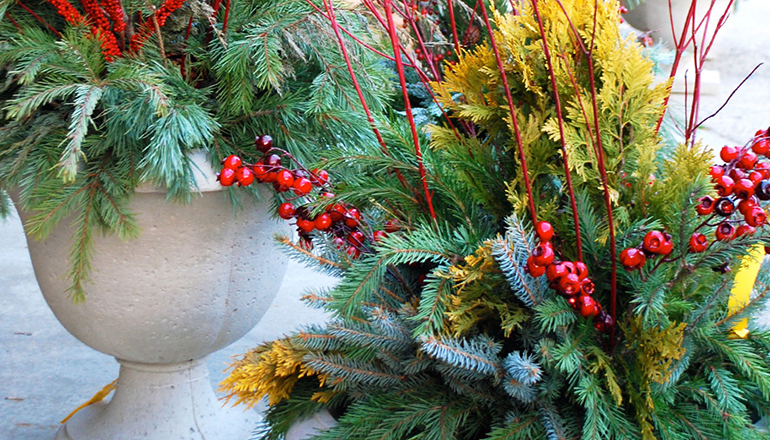Keep safety in mind when decorating with holiday greenery. Evergreens, holly, mistletoe and other traditional yuletide plants can pose risks, says University of Missouri Extension horticulturist David Trinklein.
In days of old, people rarely brought holiday greenery into the home before Christmas Eve, Trinklein says. Doing so was considered bad luck for the coming year. Today, however, the holiday season starts with Thanksgiving and lasts through New Year’s Day. Plant material brought into the home at the beginning of the season is likely to dry by January 1st.
“When it comes to greenery, freshness is important since aged, dry material becomes more of a fire hazard in the home,” he says. While relatively fresh greenery might be available from a local retail outlet, he adds, “the very freshest greenery comes from one’s own landscape and should be used whenever possible.”
Whatever the source of greenery, Trinklein advises placing cut ends in water. If your greenery came from a retail outlet, re-cut the stems before immersing them in water. Keep the plant material in the coolest place possible until it is time to move it indoors. Freezing temperatures will not harm the greenery, but unfrozen water should be available to the stems at all times during storage.
To promote safety and prolong the useful life of holiday greenery, keep stems in water after moving them into the home. Design decorations so branches fit into a container that holds water. Trinklein suggests adding floral preservatives such as those used for cut flowers. Change the preservative solution weekly.
Don’t place decorations containing greenery near hot air ducts, radiators or other heat sources. Never put decorations with greenery near fireplaces, where sparks from an open flame might ignite them.
Some traditional plants contain toxic compounds that might pose a health risk, especially if children are present, Trinklein says. For example, the red berries of holly are considered mildly poisonous and can cause nausea, vomiting, and diarrhea if ingested. Children and pets often are attracted to these bright berries. Keep holly well out of the reach of youngsters and make sure any berries that might fall from the decoration won’t land on the floor where they can be retrieved by a child or pet, he says.
Branches of the common evergreen yew shrub are often are cut for holiday use. The leaves, bark, and seeds of yew are considered toxic. Yew produces a small red fruit that might be attractive to children. The pulp of the fruit is harmless, but the seeds can be quite toxic.
While mistletoe is steeped with folklore and tradition, it should be used with extreme care, Trinklein says. Both American and European types are highly toxic. It is probably best to use artificial mistletoe for holiday decorations, he says. If using fresh mistletoe, wrap it with plastic so the leaves and berries cannot fall to the floor.







